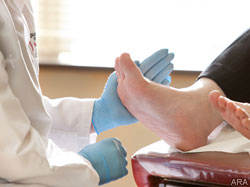(ARA) – It makes sense to take care of your feet at any age and any health level – after all, they’re the foundation on which we walk through our daily lives. For people with diabetes, however, caring for their feet takes on a new importance, as diabetes-related complications prompt the amputation of more than 1.5 million feet and legs every year.
In fact, more than 60 percent of non-traumatic, lower-limb amputations in the U.S. are performed on people with diabetes, according to the American Podiatric Medical Association (APMA). If you or someone you love lives with the disease, knowing how to take care of your feet, and how to recognize signs of diabetes-related complications, is an important element of successfully managing the disease.
“Research has shown that up to 25 percent of people with diabetes will develop a foot ulcer in their lifetime,” says Dr. Kathleen Stone, president of the APMA. “Foot ulcers and infections are the most common reason for hospitalization of those with the condition. However, these problems are largely preventable.”
Common foot problems related to diabetes include neuropathy, skin changes, calluses, foot ulcers, poor circulation and infections. Because diabetes can cause nerve damage in extremities, a person with the disease may not immediately be aware of, or feel pain from, an injury or ulcer. Small wounds or cuts on the foot that are slow to heal can develop into ulcers, which, if left untreated, can become infected and lead to partial or full amputation of the foot or lower leg, according to the APMA. However, regular care from a podiatrist can reduce amputation rates 45 to 85 percent.
People with diabetes should inspect their feet daily and be vigilant for these warning signs of ulcers, the most common type of diabetes-related foot complication:
* Irritation
* Redness
* Cracked or dry skin (especially around the heels)
* Drainage on socks
Ulcers can appear anywhere on the foot or ankle, but are typically found on pressure points on the foot, like the ball of the foot or bottom of the big toe. If you discover an ulcer or have any symptoms, see a doctor immediately. In many cases, the foot can be saved with early treatment by a podiatrist working as a member of the health care team caring for a person with diabetes. .
In addition to examining your feet every day, and keeping your blood glucose in your target range, make sure to follow these foot health tips:
* Trim toenails straight across and file the edges.
* Never go barefoot. Shoes should be comfortable and fit well (the APMA website, www.apma.org, offers guides on how to choose footwear that fits properly). Check the inside of shoes before putting them on to be sure there is nothing inside the shoe that will irritate or harm your feet.
* Since diabetes risk can be hereditary, people with diabetes should talk to their families about monitoring their own blood sugar and foot health.
* When sitting, elevate your feet. Wiggle toes and move your ankles up and down several times a day for five minutes.
*Diabetes is a hereditary disease, and is often passed down from parent to child. Families affected by diabetes should openly discuss the hereditary nature of diabetes, and its negative physical effects.
“Podiatrists are an integral part of the diabetes management team, and are experts in wound care,” says Stone. “They can help patients with diabetes avoid ulcers and treat foot problems that arise. To find a podiatrist in your area, visit www.apma.org. For the latest information on diabetes and foot health, follow APMA on Twitter at www.twitter.com/APMAtweets.

